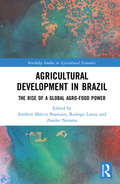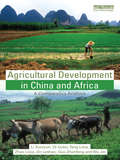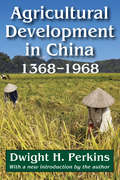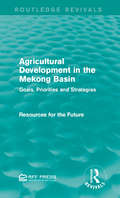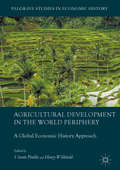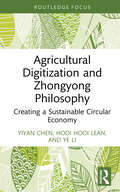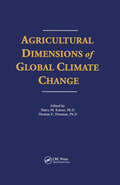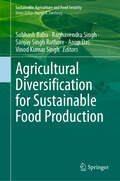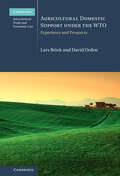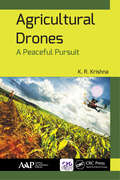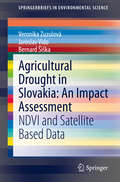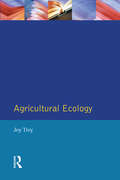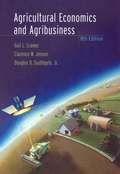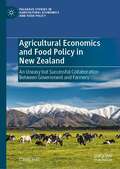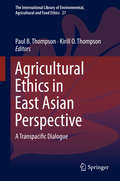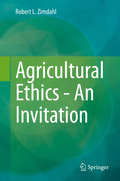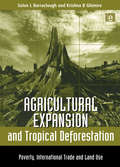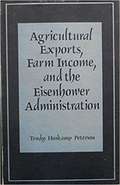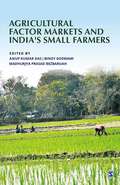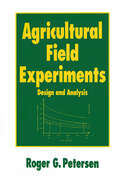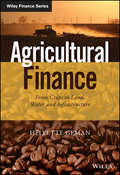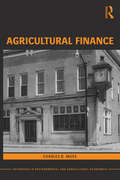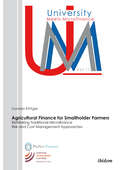- Table View
- List View
Agricultural Development in Brazil: The Rise of a Global Agro-food Power (Routledge Studies in Agricultural Economics)
by Antonio M. Buainain Rodrigo Lanna Zander NavarroIn the last few decades, Brazilian agriculture has experienced a seismic transformation, and its contradictory facets have fed different and opposing narratives regarding recent changes. This book covers these changes, exploring the issues from several empirical and analytical angles, including the role of agriculture in the contemporary Brazilian economy, the dynamics of Brazilian agricultural value chains, environmental challenges and the processes of social differentiation. Brazilian agriculture continues to be viewed in the international literature, either through the lenses of the past century – those of former problems relating to land use and land tenure – or apologetically. This collection of essays aims at updating the current interpretations, providing objective accounting of the main transformations, its determinants, results, contradictions and limitations. As it covers the most relevant traits of Brazilian agricultural and rural development, the book will provide the reader with an encompassing view of contemporary Brazilian agriculture, including the positive and negative sides of the so-called tropical agriculture revolution. It highlights the tremendous economic potential as well as the continuing structural heterogeneity, concentration of production and marginalization of millions of small farmers. Written in an engaging and accessible style, this book will be perfect for all those interested in learning about Brazilian agriculture. It will be of particular interest to undergraduate and graduate students of economic development, agricultural economics, rural sociology, comparative economic development, rural development and agricultural policies.
Agricultural Development in China and Africa: A Comparative Analysis
by Li Xiaoyun Qi Gubo Tang Lixia Zhao Lixia Jin Leshan Guo Zhanfeng Wu JinMany African countries are increasingly interested in learning from China's experiences in achieving effective agricultural development. The Chinese government and academic community are also keen to share experiences and lessons with Africa. China made agriculture one of its development assistance priorities at the Third FOCAC Summit in Beijing in 2006. This systematic comparative study of agricultural development in China and Africa provides a unique basis for African countries and international organizations seeking to understand agricultural development in China, and for China to understand agricultural development on the African continent. The book highlights experiences and lessons from China and, in particular, analyzes why Africa has not yet been able to emulate China's agricultural development trajectory. It compares the similarities and discrepancies in conditions, processes, and outcomes between China and Africa from the perspectives of investment, science and technology, policies and international development aid. Based on this it explores which experiences and lessons from China's agriculture development can be shared with African countries in order to contribute to the sustainable improvement and transformation of African agriculture. It does not claim that China has all of the answers, but while recognizing the diversity within both China and Africa, concludes that much can be gained from such a comparison.
Agricultural Development in China, 1368-1968
by Dwight H. PerkinsAgricultural Development in China explains how China's farm economy historically responded to the demands of a rising population. Dwight H. Perkins begins in the year A.D. 1368, the founding date of the Ming dynasty. More importantly, it marked the end of nearly two centuries of violent destruction and loss of life primarily connected with the rise and fall of the Mongols. The period beginning with the fourteenth century was also one in which there were no obvious or dramatic changes in farming techniques or in rural institutions. The rise in population and hence in the number of farmers made possible the rise in farm output through increased double cropping, extending irrigation systems, and much else.Issues explored in this book include the role of urbanization and long distance trade in allowing farmers in a few regions to specialize in crops most suitable to their particular region. Backing up this analysis of agricultural development is a careful examination of the quality of Chinese historical data. This classic volume, now available in a paperback edition, includes a new introduction assessing the continuing importance of this work to understanding the Chinese economy. It will be invaluable for a new generation of economists, historians, and Asian studies specialists and is part of Transaction's Asian Studies series.
Agricultural Development in the Mekong Basin: Goals, Priorities and Strategies (Routledge Revivals)
by Resources for the FutureOriginally written for the International Bank for Reconstruction and Development, Resources for the future published this report in 1971 believing it would be of interest to more general readers. Resources for the Future draws on its past experience of resource utilization, development and economics to comment on issues faced by the Mekong Basin River for agricultural development such as the demand-supply conditions for improved agriculture, the limitations imposed by physical and human resource conditions and measures needed to modernize their agricultural methods. This title will be of interest to students of Environmental and Economic studies.
Agricultural Development in the World Periphery: A Global Economic History Approach (Palgrave Studies in Economic History)
by Vicente Pinilla Henry WillebaldThis book brings together analysis on the conditions of agricultural sectors in countries and regions of the world’s peripheries, from a wide variety of international contributors. The contributors to this volume proffer an understanding of the processes of agricultural transformations and their interaction with the overall economies of Africa, Asia and Latin America. Looking at the nineteenth and twentieth centuries – the onset of modern economic growth – the book studies the relationship between agriculture and other economic sectors, exploring the use of resources (land, labour, capital) and the influence of institutional and technological factors in the long-run performance of agricultural activities. Pinilla and Willebald challenge the notion that agriculture played a negligible role in promoting economic development in the nineteenth and twentieth centuries, when the impulse towards industrialization in the developing world was more impactful.
Agricultural Digitization and Zhongyong Philosophy: Creating a Sustainable Circular Economy (Routledge Focus on Environment and Sustainability)
by Ye Li Yiyan Chen Hooi Hooi LeanThis interdisciplinary book combines digital technology with Eastern philosophy to examine how the concept of Zhongyong in Confucianism can be used to coordinate digital technology with sustainable agriculture. Zhongyong comes from the connotation of moderate and sustainable in ancient Chinese culture. It is with this concept in mind that this book presents a novel collaboration between philosophy and computer technology to explain how Zhongyong can play an important part in realizing agricultural digitization within a circular economy in order to help solve the current food crisis. The book examines two popular, yet contradictory, digital technologies—blockchain and the green data center. It showcases how the use of traditional Chinese Zhongyong can promote the decentralization of blockchain and the centralization of the green data center and explains the advantages of using both technologies simultaneously. The book puts forward a digital circular agricultural framework that embeds both blockchain and the green data center through an actual case study. While this book specifically focuses on agriculture, it also provides readers with a new perspective for thinking further on how to break down the disciplinary barriers between the social sciences and natural sciences. This book will be of great interest to students and scholars of agriculture, digital technologies, circular economy, sustainable development, and Eastern philosophy.
Agricultural Dimensions of Global Climate Change
by Harry Kaiser Thomas DrennenThis important book, written by recognized leaders in their fields, discusses agricultural dimensions of global climate change. Research and policy issues are covered and a multidisciplinary view of global climate change and agriculture is presented. Major sections cover the contribution of agriculture to greenhouse gas (GHG) emissions (including an investigation as to whether monitoring and verification of such emissions would work) and the impact of global climate change on agriculture. The book examines such important issues as global food availability, distributional effects between developing and developed countries, agricultural adaptation possibilities, and whether CO2 enrichment will benefit agriculture. A unique feature of this publication is that it addresses communication difficulties between researchers and policy makers and suggests solutions.
Agricultural Diversification for Sustainable Food Production (Sustainability Sciences in Asia and Africa)
by Anup Das Vinod Kumar Singh Subhash Babu Raghavendra Singh Sanjay Singh RathoreThis book discusses agricultural diversification, nutritional security and environmental sustainability. It helps to address the multipronged challenges of nutritional security while preserving the dwindling natural resources in the current fluctuating climate conditions. Energy-intensive, conventional agricultural production systems accelerate environmental footprints, resource mining, biodiversity losses, and human health problems and reduce soil functionality. Diversified farming can potentially enhance yield, food security, and climate change buffering as it helps to achieve advanced food security by efficient resource use and profit maximization. This book covers the challenges faced during the adoption of diversified farming and opportunities to enhanced food production and minimize the environmental footprints. This book is useful for academicians, researchers, ecologists, environmentalists, students, capacity builders, and policymakers to have in-depth knowledge of this complex and diverse field. This book also helps in devising a road map for policy planning and advancement of existing knowledge for various stakeholders working in this field.
Agricultural Domestic Support Under the WTO: Experience and Prospects (Cambridge International Trade and Economic Law)
by David Orden Lars BrinkThe WTO Agreement on Agriculture subjects different groups of developed and developing countries to different limits on domestic support and allows various exemptions from these limits. Offering a comprehensive assessment of the Agreement's rules and implementation, this book develops guidance toward socially desirable support policies. Although dispute settlement has clarified interpretation of the Agriculture and SCM Agreements, gaps remain between the legal disciplines and the economic effects of support. Considering the Agriculture Agreement also in the context of today's priorities of sustainability and climate change mitigation, Lars Brink and David Orden build a strategy that aligns the rules and members' commitments with the economic impacts of agricultural support measures. While providing in-depth analysis of the existing rules, their shortcomings and the limited scope of ongoing negotiations, the authors take a long-term view, where policies directed toward evolving priorities in agriculture are compatible with strengthened rules that reduce trade and production distortions.
Agricultural Drones: A Peaceful Pursuit
by K. R. KrishnaAgricultural drones are expected to revolutionize the way we conduct agronomic procedures and maintain natural vegetation on earth. This book explores the increasing importance of the role of aerial robots in managing agricultural farms and natural resources. Agricultural Drones: A Peaceful Pursuit provides a wealth of information on drone usage in agriculture. The book discusses the advanced sensors and imaging capabilities of drones that give farmers new ways to increase yields and reduce crop damage. An introductory chapter provides historical data, with details about various models of drones as well as the most recent and popular agricultural drones in usage. The book goes onto look at such topics as the use of drones for soil fertility, production agronomy, irrigation, weed control, pest and disease control, grain yield forecasting, and economic advantages from drone use. This timely and useful volume will be a valuable resource for faculty, agricultural extension officers, and farmers and farm consultancy agencies. This book would also serve as an excellent textbook for students in agriculture, engineering, geography, etc. Key features: • outlines the advantages of using drones in agriculture, such as for the management of soil fertility, the study of natural resources and vegetation, the maintenance of adequate irrigation, and the control of weeds and pests • covers the economic advantages of using drones in agriculture • examines the regulatory aspects of agricultural drones • provides actual examples of drone usage in agriculture
Agricultural Drought in Slovakia: NDVI and Satellite Based Data (SpringerBriefs in Environmental Science)
by Veronika Zuzulová Jaroslav Vido Bernard ŠiškaThis book gives an insight into the evaluation of drought in Slovakia and provides an assessment of Normalized Difference Vegetation Index (NDVI) as a method suitable for an evaluation of drought in agricultural land. Dry seasons in the time series from 1960 to 2014 were determined according to the monthly Palmer Drought Severity Index (PDSI). The field research was carried out on 12 sites including western Slovakia, Prešov, Trnava and Nitra regions. Data collected from satellite imagery, climate data analyses and drought indices was analysed to determine the value of NDVI as an evaluation tool.
Agricultural Ecology
by Joy TivyThis book analyses the nature of the relationships between crops, livestock and the bio-physical environment, and the extent to which man has managed and modified the products and environment to suit his/her own particular needs.
Agricultural Economics And Agribusiness
by Gail L. Cramer Clarence W. Jensen Douglas D. SouthgateThis book examines the structure and organization of the agricultural industry, then discusses basic micro and macroeconomics principles as they apply to agriculture. Principles of economics are used to demonstrate to the reader that theory actually makes reality more understandable. The book is at the right level and is kept consistently up-to-date-the only text that has been consistently revised!
Agricultural Economics and Food Policy in New Zealand: An Uneasy but Successful Collaboration Between Government and Farmers (Palgrave Studies in Agricultural Economics and Food Policy)
by David HallThe book analyses agricultural economics and food policy in New Zealand, where farming produce has been by far the main export commodity. Farming exports’ importance, together with the need to diversify exports away from a former colonial relationship with the UK, makes liberalising agricultural trade a major concern for New Zealand. Farmers, themselves, have influenced, significantly, policy development and implementation through their organisation, Federated Farmers. After World War II farmers at first encouraged Government financial support for farming and by the 1980s farming was highly subsidised. Farmers recognised in the 1980s that New Zealand’s economic problems demanded reduced Government intervention and accepted ending farming subsidies. New Zealand then encouraged, globally, ‘farming without subsidies’. New Zealand projected an image of environmental cleanliness and greenness in support of its exporting but into the 21st century wrestled to maintain that image because farming impacted on water quality and climate change emissions.
Agricultural Engineering Volume 2: Proceedings of the Eleventh International Congress on Agricultural Engineering, Dublin, 4-8 September 1989
by VINCENT A.DODD; PATRICK M.GRACEThis set of proceedings volumes provides a broad coverage of basic and applied research projects dealing with the application of engineering principles to both food production and processing. The set consists of the following four volumes: Land and water use, Agricultural buildings, Agricultural mechanisation and Power, processing and systems. Includes about 450 papers from over 50 countries worldwide, drawn from the Eleventh International Congress on Agricultural Engineering, Dublin, 4-8 September 1989.
Agricultural Ethics in East Asian Perspective: A Transpacific Dialogue (The International Library of Environmental, Agricultural and Food Ethics #27)
by Paul B. Thompson Kirill O. ThompsonThis book brings together agricultural ethics scholars from the US, Japan and Taiwan to discuss crucial issues in agricultural ethics and sustainability ethics in comparative context. Agricultural ethics and sustainability ethics are wide-ranging and closely linked to environmental ethics, bioethics, virtue ethics, animal welfare, soil conservation, not to mention rural traditions and lifestyles. Six of the chapters cover historical traditions and values in Europe, the US and East Asia. Four of the chapters cover the role of virtue ethics in the analysis of agrarian and environmental ethics, agricultural biotechnology, food ethics, and alternative agriculture, respectively. Finally, two of the chapters cover field efforts of agricultural ethics involving preserving agricultural heritage and building consensus for sustainable farming, respectively. Although the papers are divided into three groups, their contents are interconnected and mutually informative.
Agricultural Ethics: An Invitation
by Robert L. ZimdahlI write because I am concerned that I and my agricultural colleagues have avoided addressing the moral dimension of the environmental and social problems we have contributed to. I hope for an exchange of ideas about agriculture's moral dilemmas. I encourage my readers to engage in a collective conversation about the dilemmas and avoid remaining in what Merton calls "the collective arrogance and despair of his own herd." If those engaged in agriculture continue to ignore and fail to realize our common difficulties they will be addressed and resolved by societal pressure and political action, which may not yield the resolution we favor. The book's goal is not to resolve the moral dilemmas raised. It is to raise them and encourage thought and discussion. It will ask but not answer why nearly all involved in agriculture have not addressed the moral concerns voiced by the general public. The agricultural enterprise is committed to the benefits and future success of the present, very productive, chemical, capital, and energy intensive system, which is, in the minds of many, not sustainable. The internal justification invokes the moral claim that they feed the world's population. The question remains whether or not the prevailing moral justification of feeding the world is adequate given all the issues modern, developed country agriculture faces: pesticides in soil, water, and food, cruelty to animals, Biotech/GMO's, corporate agriculture, pollution by animal factory waste, exploitation of and cruelty to migrant labor.
Agricultural Expansion and Tropical Deforestation: International Trade, Poverty and Land Use
by Solon L. BarracloughThere is no clear-cut causal relationship between international trade, agricultural expansion and tropical deforestation. Academics, policy-makers and the public are all tempted by simplistic solutions to complex problems. In order to establish the true causal factors involved in this critical area of environmental decline, the authors of this study present case studies ranging over three continents. Utilizing statistics, it is shown that the focus of analysis of deforestation must be applied as much to the misguided policies of national and regional authorities as to the forces of trade and globalization. Further, it demonstrates that we must adopt a critical perspective on the historical context of human use of forest areas, looking at issues such as systems of land tenure. The primary aim of the book is to highlight the need to seek solutions in far-reaching institutional and policy reforms adapted to specific socio-economic and ecological contexts, if the problem of tropical deforestation is to be tackled effectively.
Agricultural Exports, Farm Income, And The Eisenhower Administration
by Trudy PetersonAgriculture -- Economic aspects -- United States -- History.
Agricultural Extension Worldwide: Issues, Practices and Emerging Priorities (Routledge Revivals)
by William M. Rivera; Susan G. SchramFirst published in 1987, Agricultural Extension Worldwide presents an international perspective on agricultural extension and highlights extension as an integral function of agricultural development. Agricultural extension is one of the largest nonformal problem-solving educational systems in the world. It is generally concerned with transferring knowledge and research to farmers but may include services to other target audiences such as farm families and rural youth, as well as serve for developing rural community resources. In sixteen chapters, various major systems of extension are discussed along with factors that make for their success or failure, including the linkages required and the policy and financial supports necessary to make them effective. This book is a must read for scholars and researchers of agricultural economics, agricultural policy and agriculture in general.
Agricultural Factor Markets and India’s Small Farmers
by Anup Kumar Das Binoy Goswami Madhurjya Prasad BezbaruahIncompleteness and imperfections of the factor markets can inhibit farmers, particularly small farmers, from optimal utilization of resources, which limits the performance of the whole agriculture sector. In small farm agriculture, several important markets handling allocation of vital inputs and services have been emerging. Emerging markets such as the rental markets of farm machinery and equipment have received little attention in literature. Agricultural Factor Markets and India’s Small Farmers argues that the market efficacy for such critical services requires close examination. The decline of public sector provided extension service in the post Green Revolution period and the entry of private providers makes this especially important. Further, thinness of markets for farm credit, insurance and marketing services deserves incisive analysis, as small farms are often constrained by insufficiency of access to such services. The book analyses different factor markets to explore their interconnectedness and presents a comprehensive study on the factor market system.
Agricultural Field Experiments: Design and Analysis (Books in Soils, Plants, and the Environment #Vol. 31)
by Roger G. PetersenThis text provides statistical and biometrical procedures for designing, conducting, analyzing and interpreting field experiments. It addresses the most important research topics in agriculture, including agronomy, breeding and pasture trials; farming systems research; and intercropping research.
Agricultural Finance
by Helyette GemanA comprehensive resource for understanding the complexities of agricultural financeAgricultural Finance: From Crops to Land, Water, and Infrastructure is a pioneering book that offers a comprehensive resource for understanding the worldwide agriculture markets, from spikes in agricultural commodity prices to trading strategies, and the agribusiness industry generally to the challenges of feeding the planet in particular. The book also goes in-depth on the topics of land, water, fertilizers, biofuels, and ethanol. Written by Helyette Geman--an industry expert in commodity derivatives--this book explores the agricultural marketplace and the cycles in agricultural commodity prices that can be the key to investor success.This resource addresses a wide range of other important topics as well, including agricultural insurance, energy, shipping and bunker prices, sustainability, investments in land, subsidies, agricultural derivatives, and farming risk-management. Other topics covered include structured products and agricultural commodities ETFs; trade finance in an era of credit shortage; securitization and commodity-linked notes; grains: wheat, corn, soybeans; softs: coffee, cocoa, cotton; shipping as a key component of agricultural trade; and the major agricultural shipping routes and the costs. The book:Offers the first comprehensive resource that deals with the all aspects of agricultural financeIncludes information that is crucial for pension funds, asset managers, hedge funds, agribusiness corporates, CTAs and regulatorsCovers a range of topics from agricultural bunker prices, futures, options to major shipping routes and the costsThis text is a must-have resource for accessing the information required to trade successfully in the agricultural marketplace.
Agricultural Finance (Routledge Textbooks in Environmental and Agricultural Economics)
by Charles B. MossThis textbook integrates financial economics and management in the area of agricultural finance. The presentation of financial economics discusses how the credit needs of farmer/borrowers are met by depositors through commercial banks. The financial management content presents methods used to make farm financial decisions including farm accounting, capital budgeting, and the analysis of risk. The textbook begins by developing the farm financial market focusing primarily on the market for debt. Next, the textbook presents an overview of accounting concepts important for the credit market. The accounting section provides a detailed discussion of the Farm Financial Standards Council’s suggestions for agricultural financial statements. Following the financial accounting, the book presents the use of ratio analysis applied to the farm firm. Next, the text describes capital budgeting followed by an introduction to risk analysis. Finally, the book presents the effect of debt decisions on the farm firm. In addition to the primary topics, the textbook includes a discussion of agricultural banking and monetary policy and an analysis of the choice of historical cost and market valued accounting methodologies on the farm debt decision.
Agricultural Finance for Smallholder Farmers: Rethinking Traditional Microfinance Risk and Cost Management Approaches (University Meets Microfinance #11)
by Daniela RöttgerEven though traditional microfinance has successfully paved the way for offering financial services to low-income populations without traditional collateral, many microfinance institutions (MFIs) are still reluctant to move into rural areas and agricultural finance, due to the perceived high risks and costs. Daniela Röttger's research demonstrates how MFIs can mitigate risks and costs of lending to smallholder farmers by using a combination of proven traditional microfinance mechanisms while adapting specific loan features and lending mechanisms to the particularities of smallholder agriculture. <P><P>She systematically compares traditional microfinance risk management mechanisms with agricultural microfinance approaches and identifies successful strategies. Eight MFIs providing agricultural finance to smallholder farmers in four countries in East and West Africa (Uganda, Kenya, Benin, Cameroon) were interviewed and their loan features and agricultural lending mechanism were analyzed. The study shows that MFIs can successfully serve smallholder farmers in rural areas. A strong commitment combined with sound in-house knowledge of agricultural value chains and the flexibility to adapt loan terms and lending procedures to the particularities of agriculture are needed to successfully develop and sustain agricultural microfinance.
